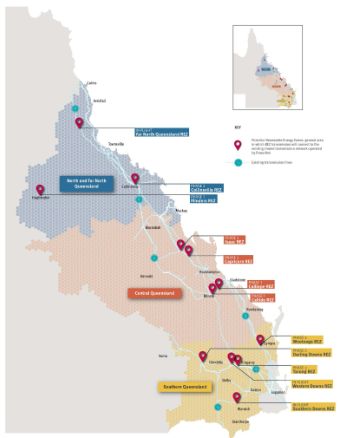- within Compliance topic(s)
- with Inhouse Counsel
- in United Kingdom
On 10 July 2023, the Queensland Government published the Draft 2023 Queensland Renewable Energy Zone Roadmap (Draft Roadmap) for community feedback.
Renewable Energy Zone (REZ) development is a key component of the Queensland Energy and Jobs Plan and meeting the State's renewable energy targets. The Draft Roadmap details the Queensland REZ Framework to be established under new legislation and the pathway to connect 22 gigawatts of new wind and solar energy to the Queensland electricity grid.
Snapshot
- The REZ Framework detailed in the Draft Roadmap will be enabled in legislation through the draft Energy (Renewable Transformation and Jobs) Bill (Draft Bill).
- Under the new legislation:
- the Minister for Energy will declare individual REZs; and
- Powerlink Queensland (Powerlink) will be the REZ Delivery Body responsible for developing the REZs.
- The Draft Roadmap identifies 12 potential REZs to be developed in the Southern, Central, and North and Far North Queensland regions, across three phases to 2035.
- The REZs are proposed to be developed following a four-stage process involving planning, declaration, construction and operation and commissioned stages.
- The Draft Roadmap also recognises the ongoing work between the Commonwealth and Queensland governments to develop bioregional plans to provide for clear signals to industry to areas to be protected and developed. This is in line with the Commonwealth Government's "Nature Positive Plan" which outlines the approach to reform of Federal Environmental Laws.
- Regional Energy Reference Groups are to be created to facilitate stakeholder involvement.
REZ Framework
The REZ Framework detailed in the Draft Roadmap will be enabled in legislation through the Draft Bill. The Draft Bill was released on 3 June 2023 and is scheduled for introduction to Parliament in late 2023. More information on the Draft Bill can be found here.
Under the new legislation, REZs will be declared by the Minister for Energy and Powerlink will be appointed as the REZ Delivery Body responsible for developing the REZs including coordinating and optimising projects connecting in each declared REZ.
The current 'open-access' connection to the electrical network under the National Electricity Laws and National Electricity Rules will be altered by the new legislation to focus on coordinating renewable project connections.
However, throughout REZ development, individual projects will still be required to undergo planning and assessment processes required by all levels of government.
The process for developing REZs is described in four stages:
- Planning: Early engagement and investigations into potential sites and areas of potential REZ development signalled through the REZ Roadmap. The Draft Roadmap recognises that there may be an opportunity to use project facilitation mechanisms to ensure timely and coordinated outcomes.
- Declaration: under the new legislation, Powerlink will make recommendations to the Minister for Energy for REZ declarations. The REZ is declared and Powerlink publishes a draft REZ Management Plan for consultation.
- Construction and operation: The final REZ Management Plan is published. Construction of REZ infrastructure begins. Powerlink will work with project proponents to connect projects over time, in line with the REZ Management Plan.
- Commissioned: the REZ reaches full operation.
REZ Readiness Assessments
The Queensland Government has allocated at least $6 million to undertake an initial Strategic REZ Readiness Assessment of the three regions where REZs will be developed, being the Southern, Central, and North and Far North Queensland regions. This initial assessment is anticipated to include studies into:
- opportunities and priorities as part of REZ development across regions;
- potential implications for infrastructure, transport, housing and accommodation, workforce, supply chains, waste management, other land uses, and social infrastructure; and
- community input and perspectives including local industry and First Nations considerations.
These studies will inform planning for individual REZ declarations and feed into other government planning processes including the State's bioregional planning with the Commonwealth Government and review of the planning framework.
REZs will be incorporated into the State planning framework through regional plans and infrastructure planning processes to enable long-term planning for renewable development.
More granular planning activities including community engagement on specific infrastructure proposals by Powerlink and connecting renewable energy projects will follow each REZ declaration.
Community involvement and investment'
The Draft Roadmap proposes to integrate local and industry involvement in the REZ development process through the establishment of Regional Energy Reference Groups to:
- help to identify the initiatives that should be supported through community investment schemes;
- provide input into REZ Readiness Assessments; and
- advise on opportunities and issues relating to REZs and the energy transformation more broadly.
The Draft Roadmap notes an opportunity to expand current community investment to secure a positive energy legacy for REZ communities. This could take the form of a coordinated investment scheme to which renewable energy developers can contribute.
Potential REZ locations
The Draft Roadmap identifies potential REZs in various stages of development, including:
- In-flight: REZs that are already underway under existing National Electricity Rules with some degree of coordination and may be converted to a declared REZ in the future.
- Phase 1: REZs to be delivered between now and 2024.
- Phase 2: REZs to be delivered between 2024 and 2028.
- Phase 3: REZs to be delivered post-2028.
Indicative REZ locations have been identified based primarily on network capacity and investor interest considerations. Factors influencing location also included proximity to industrial and residential energy customers, ecological significance, agriculture, heritage, hazards and mining.
The potential REZs are:
- In North and Far North Queensland, the:
- Far North Queensland REZ (including the Kaban Wind Farm) (in-flight);
- Collinsville REZ (phase 2); and
- Flinders REZ (phase 1).
- In Central Queensland, the:
- Isaac REZ (phase 2);
- Capricorn REZ (phase 2);
- Calliope REZ (phase 1); and
- Callide REZ (phase 1).
- In Southern Queensland, the:
- Woolooga REZ (phase 2);
- Darling Downs REZ (phase 2);
- Tarong REZ (phase 3);
- Western Downs REZ (including the Wambo Wind Farm) (in-flight); and
- Southern Downs REZ (including the MacIntyre Wind Farm) (in-flight).
Additional REZs may be identified over time as new opportunities emerge, such as the growing hydrogen sector or connection of the North West Minerals Province through CopperString. It is anticipated that the Draft Roadmap (and Queensland SuperGrid Infrastructure Blueprint) will be updated every two years to reflect the latest market outlook for long-term planning.

Source: Powerlink Queensland, 2023 [Online]. Available from: https://www.powerlink.com.au/queensland-renewable-energy-zones [Accessed 13 July 2023].
Next Steps
Consultation on the Draft Roadmap closes on Friday 22 September 2023. The Queensland Government has specifically requested submissions in relation to the following questions:
- What should the strategic and detailed REZ Readiness Assessments focus on to maximise local opportunities and manage impacts from REZ development?
- How should Regional Energy Reference Groups be established and what role should they play in setting local investment priorities and shaping REZ outcomes?
- Should there be a coordinated scheme in place to invest in local priorities to leave a positive legacy for REZ communities and how should this operate?
- What else do we need to consider for REZ development in Queensland?
Submissions can be emailed to: REZRoadmap@epw.qld.gov.au
The content of this article is intended to provide a general guide to the subject matter. Specialist advice should be sought about your specific circumstances.











